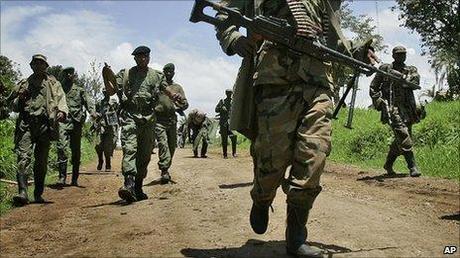
Couresty: BBC
Hell On Earth: Understanding the Congo
Part 3: The Inferno Rages On
See Part 1 here
See Part 2 here
The Rule of Mobutu
Mobutu encountered two main problems once he became the ruler of the Congo: legitimacy and an underdeveloped military. To deal with his military, he “began modernizing the army with new equipment to provide prestige to the military and to accommodate the senior officers with whom he seized power in 1965, and the acquisition of modem equipment paralleled the enlargement of military spending.”[1] Mobutu also sent large amounts of officers to Western military schools. All of this was done with the goal of building an apolitical institution in the Congo.
To gain legitimacy, he absorbed 22 civilians from all over the country and across political parties into his government and appropriated Lumumba’s nationalism by declaring him a national hero and nationalizing the Mining Union of Upper Katanga, which, to the ordinary Congolese, looked like a revival of nationalist principles. Politically, he created a political party called the Popular Movement of the Revolution and amended the constitution to institutionalize it as the only legal political party.
The Mobutu regime was marked by massive corruption, with the ruling elite using the state for self-enrichment. During Mobutu’s 32 year reign (1965 to 1997), the country “accumulated an external debt of roughly US$ 14 bn. At the same time the living standards of the vast majority of Congo's people deteriorated from an already low base” and by the 1980s, 70 percent of the population was impoverished.[2] While all this was going on, “Mobutu and his associates amassed remarkable personal fortunes” with “Mobutu's own assets reportedly [peaking] in the mid-1980s at US$ 4 bn.”[3] Mobutu and his cronies were not the only ones to benefit. The US benefitted greatly as while they gave Zaire more than $1.5 billion in economic and military aid, US companies “increased their share of the ownership of Zaire’s fabulous mineral wealth” and on a geopolitical level, Mobutu “a stabilizing force and a staunch supporter of U.S. and Western policies.”[4] The regime was also aided by the French as they “contracted for a number of prestige infrastructure projects- major contributary factors to Zaire’s national debt which would top $8 billion by I 996 - in exchange for guaranteed French protection for Mobutu.”[5] However, Mobutu’s ill-gotten gains would not last long as he in 1997 he would be disposed.
Civil War and the End of Mobutu
The fall of Mobutu occurred due to a number of factors. Externally, due to a withdrawal of US support and a war between the joint forces of Uganda, Rwanda and the Alliance of Democratic Forces for the Liberation of Congo-Zaire (ADFL) led to the collapse of the regime.
With the collapse of the Soviet Union in 1991, the Cold War, and with it the threat of Communism, officially ended. The US began to change its foreign policy in order to encourage democratization around the world. With regards to Africa, the US “announced that future foreign assistance to Africa would be conditioned upon democratization”[6] and made good on this promise by cutting Mobutu off in 1992. The US further withdrew from Africa due to “Somalia Syndrome” regarding the Black Hawk Down incident. “Reeling from the debacle in Somalia, and with the Rwandan genocide already unfolding, Clinton issued Presidential Decision Directive 25, which sought to strictly limit future U.N. missions, and especially U.S. participation in them.”[7] Thus, with the lack of US support, Mobutu was left to fend for himself. Yet, he was soon to be affected by outside forces within the region.
Around this time the genocide in Rwanda was already well under way and the “genocidal forces made up of the remnants of the army of the ancien régime and the extremist Interahamwe militias” fled to the Congo. The Rwandan military pursued them, but needed Congolese allies to give its incursion into the Congo some legitimacy. This alliance was found in the form of “Laurent-Désiré Kabila, a retired revolutionary involved in cross-border business ventures, and among the Congolese Tutsi, who were fighting for recognition of their citizenship.”[8]
A number of nations in addition to Rwanda, including Uganda, wanted Mobutu out of power as the Congo “served as a rear base for attacks by armed movements against Uganda, Rwanda and Burundi; and the support offered by Mobutu to the Angolan rebel movement UNITA had not ceased with the 1994 Lusaka peace accord.”[9]
There was an ethnic component to the war as well. The Congolese Tutsi were viewed by Mobutu as being more loyal to Rwandan Tutsis than to the Congo. This led to pogroms and a small level of ethnic cleansing in the Kivu region, which is directly west of Rwanda. The Tutsi resisted with the aid of the Rwanda Patriotic Front. The Congolese Tutsi took part in the 'rebellion of the Banyamulenge' which started in September 1996 and was the start of the campaign that put Kaliba into power.
Yet, it was not just the Tutsis that aided Kaliba, but also the United States due to the strategic location and natural resource wealth of the Congo. Kaliba was visited by the Political Counselor to Kinshasha, the capital of the Congo, and US Ambassador Peter Whaley. The leader of the Rwandan rebels, Paul Kagame, “was trained at the US Army’s Command and General Staff College at Fort Leavenworth in Kansas.”[10] Soon economic ties were established with the rebels as soon as the rebels took Kisangani, the capital of Orientale Province, North American mining companies rushed to get generous contracts; among them was the “Canadian-owned Tenke Mining Corp, which in May 1997 won a contract of $50 million to exploit the world’s largest copper and cobalt deposits” and “America’s Mineral Fields which signed a contract of $1 billion with the ADFL.”[11] Thus, a Kaliba victory was also a victory for the United States.
The fight against Mobutu’s forces was not difficult as they were unpaid and Mobutu had “kept [them] weak and divided so that it would not pose a threat.”[12] This resulted in the swift overthrow of his fleeing to Morocco, where he died in September 1997. In his place, Kabila came to power.
Second Congo War
Rather than establish the democracy that many had hoped for, Kaliba quickly established a one man rule and used public enterprises to “rapidly generate finances through indiscriminate concession granting;” overall his rule was marked by “corruption, patronage, and lack of accountability.” [13]
The Kaliba regime was quickly drawn into conflict, however, as rebel groups from Uganda, Rwanda, and Burundi continued to use Congolese territory to launch attacks from into their respective countries. Rwanda did not take these attacks lying down as then-Vice President of Rwanda stated that “if the international community was unable or unwilling to stop the delivery of weapons to the ex-FAR and Interahamwe and the military training in the refugee camps, the Rwandan government could decide to take preventive military action.”[14] The final split between Kaliba and the Rwandan government came when Kaliba dismissed a Rwandan military chief of Tutsi descent as the chief of staff of the military and sent all of his Rwandan allies packing in July 1998 in order to avert the possibility of a military coup against him.
In the very next month, August, troops from Rwanda and Uganda entered the Congo and the Second Congo War began, with Rwanda, Uganda, and Burundi on one side and the Congo, Angola, Chad, Nambia, Sudan, and Zimbabwe on the other.
The war lasted from 1998 to 2003, even though a ceasefire had been brokered in 1999 and UN troops deployed the year after. The war finally ended with the signing of the Pretoria Peace Accords in 2003 which called for an end to hostilities between Rwanda and the Congo and the rise of a transitional government, which was formed in July of that year.
During the Second Congo War, Kaliba was assassinated in January 2001. His son, Joseph Kaliba, took over and was even elected President in 2006. Unfortunately, the violence in the Congo would continue as the Kivu conflict arose.
Kivu Conflict
While the Second Congo War officially ended in 2003, there was still resistance in the aforementioned Kivu region. At the end of the Second Congo War, Laurent Nkunda, who had been an officer in the rebel group Rally for Congolese Democracy (RCD), was made a colonel in the transitional government and promoted to general in 2004. Yet he soon turned against the government to support the RCD.
Starting on May 26, 2004, clashes took place “between soldiers loyal to Colonel Jules Mutebutsi, a commander from the Rally for Congolese Democracy” and “pro-government forces of the newly created Tenth Military Region under the command of General Mbuza Mabe.”[15] Nkunda was stationed in the north Kivu region and sent 1,000 soldiers to support Mutebutsi. There was an ethnic aspect to this as Mabe’s forces had been killing Congolese Tutsis and thus Nkunda, being a Congolese Tutsi himself, sent forces to protect his fellow Tutsis. From there a number of atrocities have occurred, from rape to the wholesale slaughter of civilians.
While the fighting continued until 2009 and ended with the capture of Nkunda in January[16], it is a wonder that they were able to sustain themselves for that long and thus the resources within the Kivu region and foreign companies played a role in sustaining the conflict must be bought up.
The main minerals that are exploited are “gold, cassiterite, wolframite, and columbite-tantalite (coltan).”[17] These minerals, especially coltan, are “needed to manufacture everything from lightbulbs to laptops, from MP3 players to Playstations”[18] and often change hands numerous times so that it is virtually impossible for the average consumer to find out if their devices are being powered by conflict minerals.
Even though many companies are attempting to clean up their act by avoiding the use of conflict minerals, there are still problems as “while major US-registered electronics firms are outwardly pledging to end the use of conflict minerals some of these same firms belong to industry associations that are seeking to water down the disclosure requirements under Dodd-Frank,”[19] which would force corporations to disclose the fact that they are utilizing conflict minerals. The situation has not fully been worked out yet and thus the violence- and suffering- continues.

